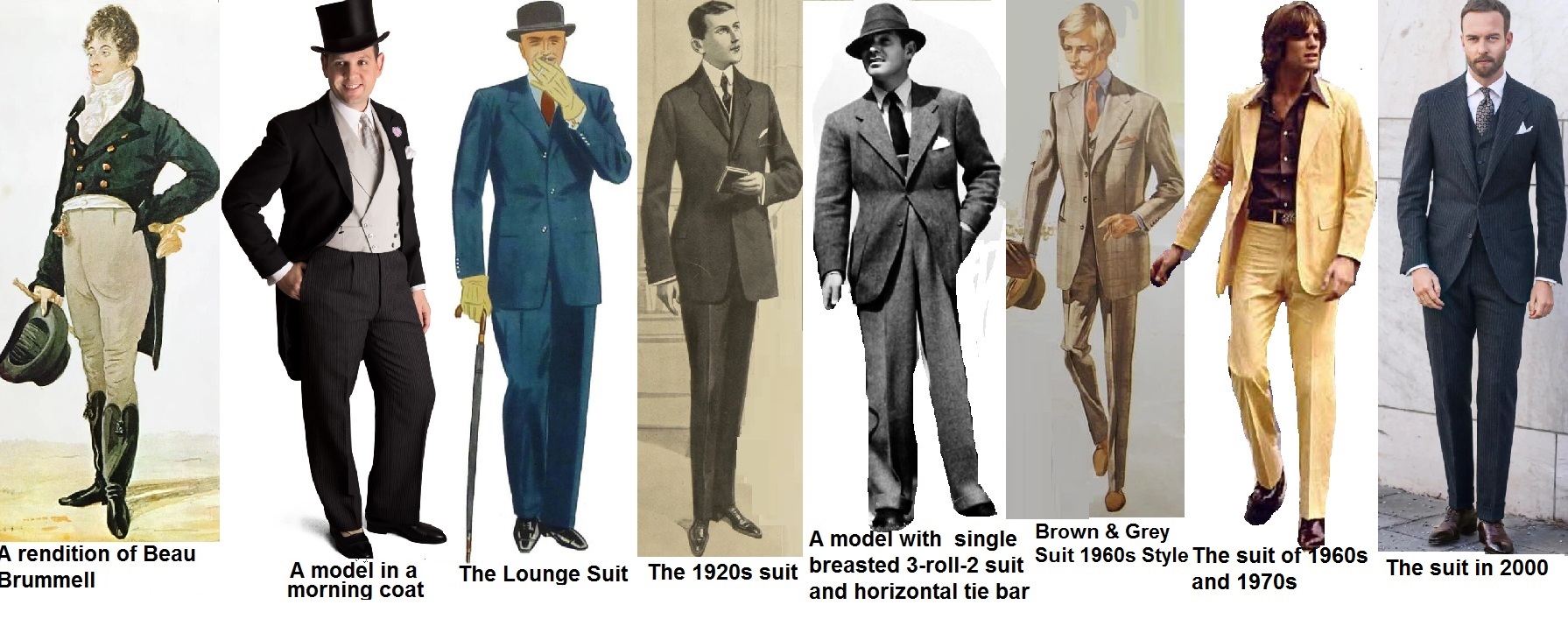
A men's suit is a formal outfit typically made up of a matching jacket and trousers, sometimes with a waistcoat. The term suit comes from the French suivre, meaning to follow, highlighting the matching design of the pieces. Its modern form traces back to Beau Brummell of 19th-century England, who replaced the ornate styles of the time with tailored trousers, boots, and simple, elegant coats.
By the start of the Victorian era (1837–1901), the black frock coat—resembling a modern overcoat with a single back vent and available in single- or double-breasted styles—had become the staple of a man’s wardrobe, typically extending to the knees. The single-breasted version was more commonly worn, while the double-breasted style—known as the Prince Albert—was considered more formal.
Later in the Victorian era, the frock coat evolved into two styles: the morning coat, with tails and a single button, used for formal daywear; and the lounge suit, developed in 1850s–60s Scotland for casual wear. The lounge suit featured matching trousers, a shorter length, no tails, and a looser, sack-like cut, making it less formal than the frock or morning coat, which were worn with contrasting trousers.
The 20th century
In the Edwardian era (early 1900s), the modern suit had largely taken form. Later changes focused on details like lapel width, jacket length, button stance, gorge height, and fabrics, rather than major alterations in structure. The lounge suit rose rapidly in popularity. Formal frock coats and morning coats were still worn but increasingly became the domain of older gentlemen and quickly fell out of favour.
The fabric used was heavy and coarse, partly due to less refined finishing and high costs. With no central heating, suits were worn indoors for warmth. Coal heating and sooty city air also influenced the choice of darker fabrics for city suits. In contrast, country suits typically showcased patterns and earthy brown shades, making them more colorful and less formal than city suits. This gave country attire a distinctly relaxed and vibrant appearance.
The 1920s
The 1920s were a transformative decade for men's suits, marked by a shift from slim, military-inspired styles to fuller, more expressive silhouettes. Early suits featured trim jackets with high buttoning points and slim, cuffed trousers, but by the late 1920s, the drape suit emerged with broader shoulders, fuller chests, and wider, high-rise trousers—creating a strong V-shaped silhouette. Pants widened to around 11.5 inches at the hem but retained a straight or slightly tapered cut for both comfort and style.
Known as the Roaring ’20s or Jazz Age, this era also brought a bold change in suit fashion, replacing dark, conservative looks with brighter colors, lively patterns, and a stylish flair. Men began accessorising with pocket squares, collar pins, and other details, rebelling against tradition through loud suits, bold stripes, and eye-catching colours. Double-breasted waistcoats were especially popular, often paired with single-breasted jackets featuring notch lapels, making the 1920s one of the most exciting and experimental periods in menswear history.
The 1930s
The 1930s suit featured a heavy drape cut with broad shoulders, strong waist suppression, and high-rise, full-cut trousers that tapered slightly at the ankles. Jackets were longer, ventless, and made from heavy fabrics that draped well and resisted wrinkles, creating a bold, masculine silhouette popular in England, the U.S., and on the silver screen. Compared to the looser suits of the late 1920s, the 1930s style was more refined with a slimmer taper through the legs.
In the 1940s, World War II led to fabric rationing, prompting simpler, minimal designs. The gray flannel suit became standard: single-breasted, narrow-lapeled, and paired with trim, cuffless trousers. Waistcoats declined, and suits grew lean and slim—resembling modern styles—though fabrics remained heavier and more textured.
The 1950s
In the 1950s, post-war rebellion influenced suit styles as fashion moved away from wartime austerity. Lapels widened, pleated pants returned for comfort, and suits became less slim. Vests declined further with the rise of central heating, echoing a shift similar to the post-WW1 style rebellion. Young men in the 1950s rebelled against their fathers' fashion by wearing T-shirts, jeans, and leather jackets. A subtler form of this rebellion was the Ivy League look, marked by the sack suit—typically a three-roll-two jacket with a single center vent and flat-front trousers. By the late 1950s, the Mod suit emerged as a new subculture style—featuring slim cuts, narrow lapels, skinny ties, and straight, flat-front trousers for a sleek, modern look.
Beyond the ’60s
Suits from the late 1960s to the 1980s evolved in fit and flair. They were closely tailored with light shoulder padding, narrow ties, and slim, slightly tapered trousers cropped above the shoes. Fabrics stayed heavy and textured, and bold-patterned sport coats were preferred. The 1970s embraced wide lapels, flared pants, and flashy, casual three-piece suits tied to disco culture. By contrast, the 1980s ushered in a more assertive style with the rise of the structured, influential power suit. The suits of the ’90s had exaggerated proportions that often looked awkward. Single-breasted jackets featured three or even four buttons, while double-breasted versions had six—but only the lowest was typically fastened, creating an unbalanced look with an unusually low buttoning point. Trousers were boxy, overly baggy, and so long they bunched up around the ankles. The new millennium marked the return of slim-fit suits, featuring shorter lengths, higher buttoning points, and narrow lapels. Black suits gained popularity for their minimalist, uniform style, often worn with cropped trousers.